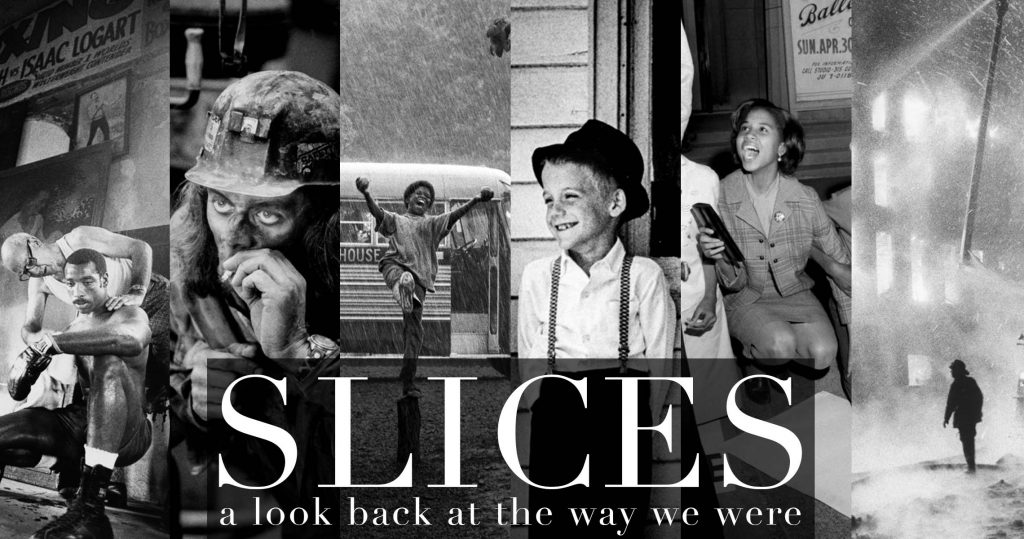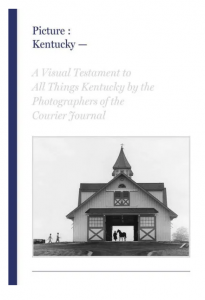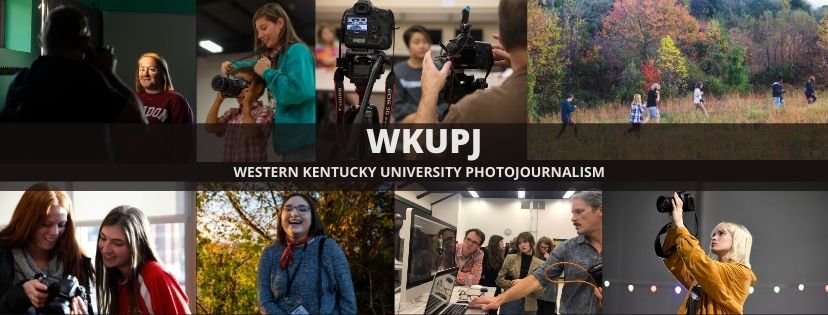
- This event has passed.
SLICES: A Look Back At The Way We Were
September 12, 2022 - November 4, 2022

From the archives of the Louisville Courier-Journal, this collection of 57 images that span six decades, document the seemingly mundane to significant events of our collective past. The Courier-Journal staff created a record of history that became immortalized in the power of photography. As time marches forward, these images freeze a layer of humanity in the click of a shutter revealing to us how much we have changed, and just perhaps, how we have not.
GALLERY HOURS:
M-W: 9:00 am – 9:00 pm
TH-F: 9:00 am – 4:00 pm
The 57 images on display as well as many more can be seen in a book published by Press Syndication Group and can be purchased here.
Readers of the Courier Journal picked up their newspapers on January 5, 1896, and found something they had never seen before. There, splashed across the front of the third section of the newspapers, were photographs – not the lithographs they had come to expect in their paper – honest-to-God, half-tone photos of state-owned buildings around the commonwealth.
 That was nine months before the New York Times began running photographs in the pages of its Sunday Magazine and years before either newspaper would put photos on their front pages. Before that, newspapers generally used hand-engraved lithographic prints to illustrate their stories, but the advent of the half-tone printing process, for the first time, began to bring the staid old publications with long columns of gray type to life. It was that page that ushered in a new era for the Courier Journal.
That was nine months before the New York Times began running photographs in the pages of its Sunday Magazine and years before either newspaper would put photos on their front pages. Before that, newspapers generally used hand-engraved lithographic prints to illustrate their stories, but the advent of the half-tone printing process, for the first time, began to bring the staid old publications with long columns of gray type to life. It was that page that ushered in a new era for the Courier Journal.
The story that accompanied the Courier Journal’s picture package that Sunday morning, buried at the bottom of the page, was almost certainly included as nothing more than a vehicle to show off the Courier Journal’s new technology – the process of using tiny dots to reproduce photos – that allowed it to bring stories to its readers like never before. The photos hinted at what the Courier Journal would become, with its corps of photographers crisscrossing the state to bring the stories of Kentucky back to its readers in a way writers never could It started with static photos of buildings, nature and mug shots of people that appeared in the third section of the paper – later called the “Half-tone Section” because of its heavy reliance on photos.
As the ability to print photographs faster and with better clarity advanced, so did photography. In years that followed, cameras went from using glass plates, to George Eastman’s roll film that first allowed for photography without a tripod, to finally in 1925, the invention of the 35mm camera. The newspaper eventually introduced color photographs to its Sunday magazine and then in the early 1990s to the newspaper itself.
In the early years, the newspaper’s photography staff wasn’t much to speak of. When reporter William Burke “Skeets” Miller won the Pulitzer Prize for reporting in 1925 after he crawled into Sand Cave in Southern Kentucky to interview trapped cave explorer Floyd Collins,he – and not a photographer – was given a camera to take the photos inside the cave. Over the years, though, the newspaper developed a dedicated photo staff that served both the morning Courier Journal and its sister publication, the afternoon Louisville Times. And with the evolution of cameras came the evolution of the Courier Journal’s great team of photographers. By the mid-1980s that staff had grown to more than 30 photographers, editors and laboratory technicians who were largely based in Louisville but who traveled to all corners of the state and beyond at a moment’s notice to cover everything from political campaigns to mine disasters to floods to life.
For more than 30 years, the staff was led by Billy Davis, the longtime director of photography who was most known for his aerial photography – shot from a series of six airplanes that the Courier Journal owned between 1953 and the mid-1990s, according to C. Thomas Hardin, who succeeded Al Allen in leading the photo staff.
It was in 1953 that Davis, an accomplished pilot who first photographed Louisville from the sky during the 1937 Ohio River flood when he was working for the Chattanooga News, convinced Courier Journal President Barry Bingham Sr., Publisher Mark Ethridge and Vice President Lisle Baker that the photo staff needed an airplane to travel the state and get shots from high above.
“We could get anywhere in the state in less than an hour and a half” former director of photography Hardin said. “It was our bureau in the sky”
Through the 1970s and 1980s, the Courier Journal photography staff either won or helped win three Pulitzer Prizes for the newspaper. The first came in 1976 when it won the award for feature photography for its coverage of forced busing and the integration of Jefferson County’s public schools. The next came four years later when reporter Joel Brinkley and photographer Jay Mather teamed up to win the Pulitzer Prize for international reporting for their stories and images of the refugee crisis unfolding in Cambodia because of the brutal rule of the Khmer Rouge.
And then in 1989, the photography staff shared a Pulitzer Prize with the newspaper’s reporting and editing staffs for their coverage of the Carroll County bus crash. The accident, among the worst in U.S. history, killed 27 people and injured 34 others when drunken driver Larry Mahoney plowed his pickup truck into an old school bus owned by the Radcliff Assembly of God Church that was returning from a youth group trip to Kings Island amusement Park near Cincinnati.
The photographs they and other Courier Journal photographers shot over the years both lift your spirit and break your heart. They tell stories of life and death. They teach us about the famous and the unknown. The extraordinary and the mundane. Many are beautiful in their simplicity, brilliant in their complexity, and they’re all, frankly, just wonderful to look at.
A book like this wouldn’t be complete without Stewart Bowman’s scene-setting photos of the Bluegrass region with the horses and barns and fences and all their iconic beauty. Nor would it seem right to publish this work without Davis aerial shot of the North Fork of the Kentucky River enveloping the city of Hazard and a smaller nearby community during the floods of 1963.
There are photos of young, thin, beautiful Elvis. And there’s an older, jump-suit-wearing Elvis in his decline. Baryshnikov and Beach Boys. Mick Jagger and Elton John. And James Brown. Bill Monroe. Aretha
There is history – like Charles Lindbergh, his darkened face visible in the cockpit of the Spirit of St. Louis parked on the tarmac at Louisville’s Bowman Field. And presidents from Franklin Roosevelt through Donald J. Trump.
Some of the photos are shot in a brief window while others show the incredible access granted the photographers and the painstaking hours of sitting, waiting, for the perfect shot. The perfect moment.
Sadly, many earlier photos you won’t see here were destroyed in the 1937 flood. Still many of the older negatives that survived the flood or were shot in the years shortly after are blistering and lost to time. But so many of the photos live on. And they tell stories. Our stories. The stories of our fathers and mothers. And their fathers and mothers.
Whether it’s a car with its rear end hanging from a chain and a mechanic poised with a steam gun to clean it after a flood, whether it’s people from a protestant church handling snakes in rural Kentucky or the body of a man who leaped to his death from a building in downtown Louisville, the photos do the job that words alone can’t do.
There’s a soldier mourning over a flag-draped coffin in one photo and a soldier – pint of Seagram’s whisky in hand – laying a big celebratory smooch on a woman in another.
Some of the most striking photos, however, are the ones that simply tell a story of everyday life, ones that don’t focus on big, important events or big, important people. They are the ones that don’t complement a story but tell a story all their own. A master of that was Pam Spaulding, who began photographing a young lawyer and his family for a newspaper project in 1977 and continues to photograph the family to this day. The images she made of the McGarvey family – including one with the mother lecturing one son and holding another while the family dog is on the exam table in the veterinarian’s office – could be a scene from any of our lives.
It was the result of painstaking work and hours upon hours of sitting and waiting, and it’s a project like none other in the history of photojournalism
“I used to tell photographers, ‘Don’t go in and feel like you have to entertain. Go in, be nice and be boring,” Hardin said.
Bill Luster’s fabulous shot of grannies – both embarrassed and intrigued – at a Chippendales show at the Toy Tiger Lounge and Hardin’s photo of former Gov. A. B. “Happy” Chandler greeting a voter in the middle of a Western Kentucky street, are both examples of photographers positioning themselves in the right place and waiting for the right time to press the shutter. Many of the photographers in these pages have gone on to work for publications known for their photographs, like National Geographic and LIFE Magazine, while others have spent their entire careers at the Courier Journal. And many of them continue to make incredible images that grace the pages of the Courier Journal today.
